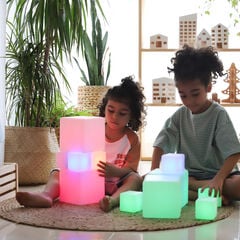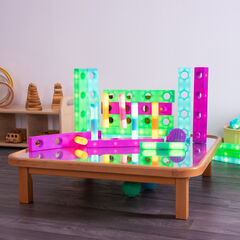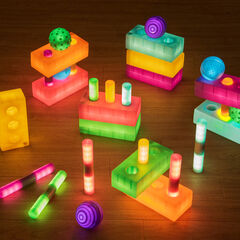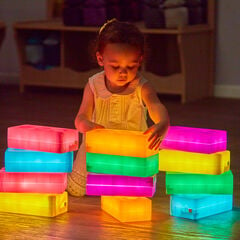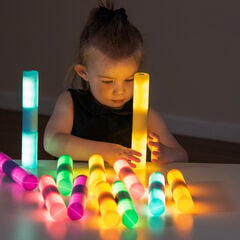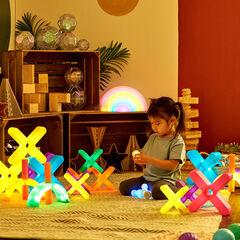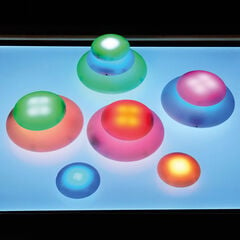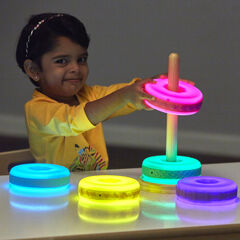In this blog, Ben Kingston-Hughes explores the power of light and how light up resources can enhance children’s learning and engagement.
Some of you will already know from previous articles that I collect torches and always have multiple torches on my person wherever I go. What could possibly go wrong with this harmless hobby? Well, I’ll tell you what can go wrong. Glowing trousers, that’s what!
Glowing feedback
I recently did a keynote speech and could not understand why the audience seemed distracted and were not often making eye contact. In fact, many of the audience were staring with a kind of confused fascination at somewhere just below waist height. You know when you can just tell there is something off about the atmosphere in a room but you can’t quite put your finger on why. It turns out that the torch in my trouser pocket had inadvertently been switched on and a certain area of my anatomy was now glowing brightly. Unfortunately, this also caused the torch to overheat so the first I was aware of my predicament was when I yelped in pain and frantically dug about in my pockets to remove the now burning hot torch.
So why were the audience so fascinated with my glowing trouser area and what has this to do with light up bricks and the power of light? (No, I didn’t misread the brief). It is to do with this fascination we experience when things light up. Ever since the first cave people made fire we have been fascinated by creating light.
Building Relationships
One of my projects is working with newly adopted children to help them bond with their new families. As you can imagine, some of these children are extremely vulnerable. I recently watched one young boy become absolutley spell-bound by our TTS Light-Up Construction Bricks and spend the next 30 minutes meticulously building the most intricate tower with his new Mum. His levels of engagement and concentration were off the scale at this point. The Mum was also fully engaged and equally fascinated.
So, what do these light-up resources and my glowing trousers have in common?
Fascination is the key
The thing is, fascination is really important for learning. When a child uses construction resources such as building bricks, they activate huge areas of their brain, developing the following skills:
- Problem solving
- 3-dimensional spatial awareness
- Fine and gross motor skills (also essential for literacy and communication and language)
- Mathematics
If the child chooses to build what they want to build (rather than what a grown-up has told them to) they are also developing:
- Imagination and creativity
- Divergent thinking
- A growth mindset
So, if these bricks light up as well, can this really be any better?
Well, that is the great thing about light-up resources. They fascinate children and they draw the attention because they are novel and interesting. This additional level of novelty and fascination does something very interesting to the brain. If an experience is novel and fascinating it activates a filter in the brain called the “Reticular Activating System”. This filter increases focused attention and effectively uses more of the brains limited resources to access the experience. This in turn increases capability and also memory retention. Basically, if something is fascinating and novel, you pay more attention to it, use more of your brain to process it, and remember more of the experience. So, building bricks are amazing for children, but light up bricks or other light up construction are the icing on the cake because they almost always increase the level of novelty and fascination.
And there’s more
And it doesn’t end there! I have written in my previous articles such as ‘Bringing Joy through Light‘, about the fact that joyful and novel experiences increase dopamine production. Dopamine is a vital “happiness” hormone and is really important in childhood. I have also discussed the fact that surprising or unexpected happiness massively ramps up the dopamine production which means that light-up resources make us feel really good. To take that a step further, Dr Judy Willis in her articles on Joyful approaches to Education says that the increased dopamine production also has the side effect of increasing the neurotransmitter Acetylcholine. This biochemical further increases focused attention.
So, if you have construction resources, these are amazing for children. If those resources also light up they do something very special to the brain and create a unique and magical learning opportunity. Light-up resources, in addition to providing some much-needed joy also increase focused attention, use more of a child’s brain, and give a child some amazing biochemicals into the bargain.

Light up cats?
Now, I am not saying that everything should light up because that would undermine the very novelty that makes these experiences so powerful. Although, now I think about it I actually would like to live in a world with light-up dogs and cats and maybe even people. What I am saying is that a wonderful way to put a little magic into children’s lives and to increase their focused attention is to use light-up construction resources.
A final word of caution
Many of our light-up bricks turn on when shaken. The first time I hit a speed bump at night the whole collection lit up in the back of the van and I was so confused I thought I was being abducted by aliens.
Also, if like me you carry a torch wherever you go, make sure it is switched off before you do a talk in front of 200 people!
Many thanks to Ben Kingston-Hughes for writing this article for us.

Ben Kingston-Hughes is an international keynote speaker, author and multi award-winning trainer. He is the Managing Director of Inspired Children and has worked with vulnerable children across the UK for over 30 years. He has appeared on television several times working on a variety of children’s projects, and his distinctive blend of humour, neuroscience and real-life practical experiences have made his training invaluable for anyone working with children. His book, “A Very Unusual Journey into Play” is now available. His new book, “Why Children Need Joy: The Fundamental Truth about Childhood” is out on 22nd December 2023″.





